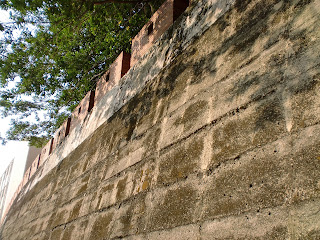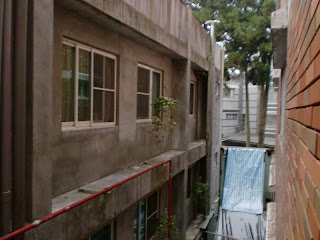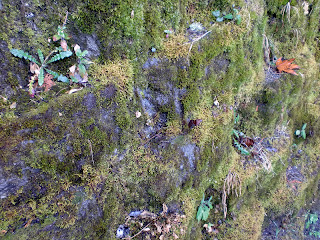I went to Alishan this past weekend with some friends from the university. Alishan is a park up in the mountains in southern Taiwan. It's not too far from Tainan. Because of it's easy accessibility, it's become one of the major nature-tourist spots in Taiwan. Lots of tour groups go up to Alishan, and one doesn't need to be in any sort of shape to go and check it out. We went as a group of 6 people and stayed for one night.
週末は学校の友達と一緒に阿里山に行って来た。阿里山は台湾の凄く有名な観光地の一つだ。山地だから、綺麗な自然が見えるし、アクセスからすれば、誰でも気楽に行ける。おばさん、おじさんばかりのツアーグループも沢山行っている。私達は6人で行って、一泊した。
泊まったホテルの窓からの景色。
Here's the view from our hotel window.
盆栽がホテル前に有った。
町(小さいから、町と言っていいかな?)の中心。
Here's a view of the town where we stayed. It's basically all hotels, restaurants and souvenir shops.
Because we were about 2000 meters above sea level, not only was it significantly cooler, but all of the sealed, packaged snacks that had been shipped up from sea level were blown up from the change in air pressure.
阿里山の町は海抜2000メートル位なので、ご覧の通り、おやつの袋は皆ぱんぱんしている。天気も涼しかった。台南は今も毎日25度を簡単に超えているけど、阿里山では、夜が10度位まで下がって、昼間でも私達はジャケットを着ていた。
金曜日、授業が終わってから阿里山に行った。結構時間がかかったので、夜に着いた。その後食事して直ぐ寝て、朝4時頃に起きて駅に行った。汽車を最高の駅まで乗って上がったら、日の出が綺麗に見える場所が有るから、そうする人が多い。
、、、でも朝起きたら、雨が降っていた!ガ〜ン。雨男/雨女は誰だったかな、、、
We left for Alishan after class on Friday morning. It takes a while to get up there, mostly because driving on the twisty mountain roads is slower going than if you were on a highway. We got to Alishan in the evening, and aside from having dinner we didn't do much. However, that was because we planned on getting up at 4 am the next day to see the sunrise. It's sort of a selling point in Alishan. If you take the train to the highest station, there's a place that's supposed to be nice for seeing the sunrise.
While we did manage to get up at 4, we forgot to call ahead and ask for sunshine, so we didn't see any sunrise, and we got rained on the whole day after that. Always call ahead.
駅が結構凄い。流石観光客のお金が沢山入ってるだろう。
阿里山は元々台湾の先住民が住んでいた地域だ。日本統治時代に政府は木材を狙って、阿里山をもっと開発させた。この阿里山鉄道は元々木材を嘉義市まで運ぶ為に作られた。
The station at Alishan is really fancy. It looks like they fixed it up recently. It's comically large for such a small town, but of course that's because it's not really a commuter railway that people use in their daily lives, it's a tourist railway.
The Alishan area has had people living in it for a long time. Originally, like the rest of Taiwan, the people living here were Austronesian people. In the Japanese colonial era, the Japanese government decided to develop the area to get access to the sweet, sweet mountain lumber. The Alishan railway was originally built for the purpose of hauling lumber down the mountain.
駅に着いたら、既に微かに明るく成っていた。でも日の出を逃したという心配は無かった。だって、雲ばかりでどうせ日の出が見えないと最初から分かったんだ。
この駅が台湾の最高駅だ(と思う)。ここで降りて、日の出の展望台に行って、フレンチトーストを食べながら雲を見ていた。悔しい!本当に何も見えなかった。
This is the highest station in the Alishan line, and probably the highest in Taiwan. It's 2451 meters above sea level! There's a viewing platform for watching the sunrise, but we just went up there and ate french toast (there were food stands set up) and watched the clouds while getting rained on. Oh well.
The trees up here look very different from sea level Taiwan. Since it's a lot cooler, the vegetation reminds me a lot of what I saw while hiking in Kyushu, Japan. One of the people in our group was from Oita in Kyushu, and he said the same thing. I think some of the plants in the area are native plants that resemble the plants in Japan because of the similar climate, but probably some of them were brought from Japan when the Japanese government was developing the area for logging. It wouldn't surprise me if a lot of the pines were planted by the Japanese. They plant a lot of cedars in the mountains in Japan for logging, so they probably did the same here.
私達のグループの中に、一人は大分出身の人で、彼は阿里山の風景は凄く大分に似ていると言った。長崎に住んで、九州の山をよく登った私も同意だった。阿里山の標高が高いから、他の地域より涼しい。だから、多分九州の気候にとても近いのじゃないかと思った。植物の中には、元々ここに自然に生えた物も有ると思うけど、日本人が持って来た物も多いだろう。日本の山によく杉を植えて、後で伐採するから、もしかして阿里山の杉も人によって植えられた。又、吉野桜も有った。桜はきっと日本人が持って来た物だと思う。
日の出が見えなかったのは残念だったけど、雲のお陰でこういう風景が見えた。
While it was too bad about the sunrise, all of the clouds did allow us to see views like this.
Some real, wood-burning steam trains. I think they break these out at some times during the year.
本物の汽車だ!走っている姿の写真を見たので、多分決まった時期に乗れるかなと思った。
郵便局だ!
This is Alishan's ridiculously over-built Post Office.
After the train ride in the morning, we then walked around on some of the paths. The paths are all wood-plank paths. They do this to protect the soil, but it also means that these are really easy walks. There's no real hiking involved in walking around this area.
朝、汽車で町に帰って来た以後、町周辺の散歩道を歩いてみた。自然を守る為に、歩道は板道に成っている。そのお陰で、凄く歩きやすいのだ。ここはハイキングじゃなくて、遊歩するって感じだ。
昔、或る木が死んで、そこから別の木が生えてきた。そして、その木も死んで、三世代目の木が同じところに生えている。
おばさん、おじさんのツアー観光客が沢山居た。中国から来る観光客が圧倒的に多いと前聞いた。確かに、大陸訛りの中国語が沢山耳にした。
There were about nine million tour groups passing through here when we did. From what I've heard, most of them are tourists from China. I listened to their Chinese, and I definitely did hear a lot of the continental accent.
This building is a museum now, but a sign nearby said that it was originally built in 1911. It looks so new though that I suspect that this is not the original building. I don't know for sure.
河合と言う人は日本政府に派遣されて来て、阿里山の木材に関する調査をした。
I took the picture below because this scene reminded me of the Chinese ink paintings at the Met that I always liked looking at as a kid. The long scrolls especially were often these mysterious quiet scenes of mountains covered in trees and fog, with only brief glimpses of human activity. There might be a house somewhere, a pagoda somewhere else, a man walking his ox along a path, perhaps an old man in a boat. But the humans and their buildings were always small and scatted, and the majority of the painting was taken up with clouds, trees, rivers and mountains.
この風景を見て、中国の墨絵を思い出した。子供の時から、紐育のメット美術館に行って、アジア美術を見るの好きだった。特に好きだったのは中国の墨絵だった。雲と木に覆われた山に、僅かに人間の存在が現れている風景は不思議な国の夢みたいな感じがした。この写真を見て、どこから薪を背負っている人が歩いて出て来そうだ、見渡せば、どこかのパゴダの下に、長い顎髭をしている老人が座っていそうだ。
Bridge Capacity: 6 people. Really. It said so on a sign.
After finishing with the trails, we got a van to take us down from Alishan. On the way they dropped us off at a couple of sight-seeing places.
阿里山のトレールを出て、ミニバスで山から降りた。途中でちょっとした観光地にも寄って行った。ちょうどこの日、下の写真の神社で祭が行われていた。爆竹の多くて、音楽が大きく流れていたから、凄く煩かった。
It so happened that this temple was having a festival, so it was one of the places we stopped on the way down back to Chiayi.
That's all smoke from firecrackers!
太鼓、でかっ!
そして、嘉義に着いて、そこから電車で台南に戻って来た。短い旅だったけど、楽しかった。今度どこに行こうかな。
That's it for the Alishan trip!












































































































